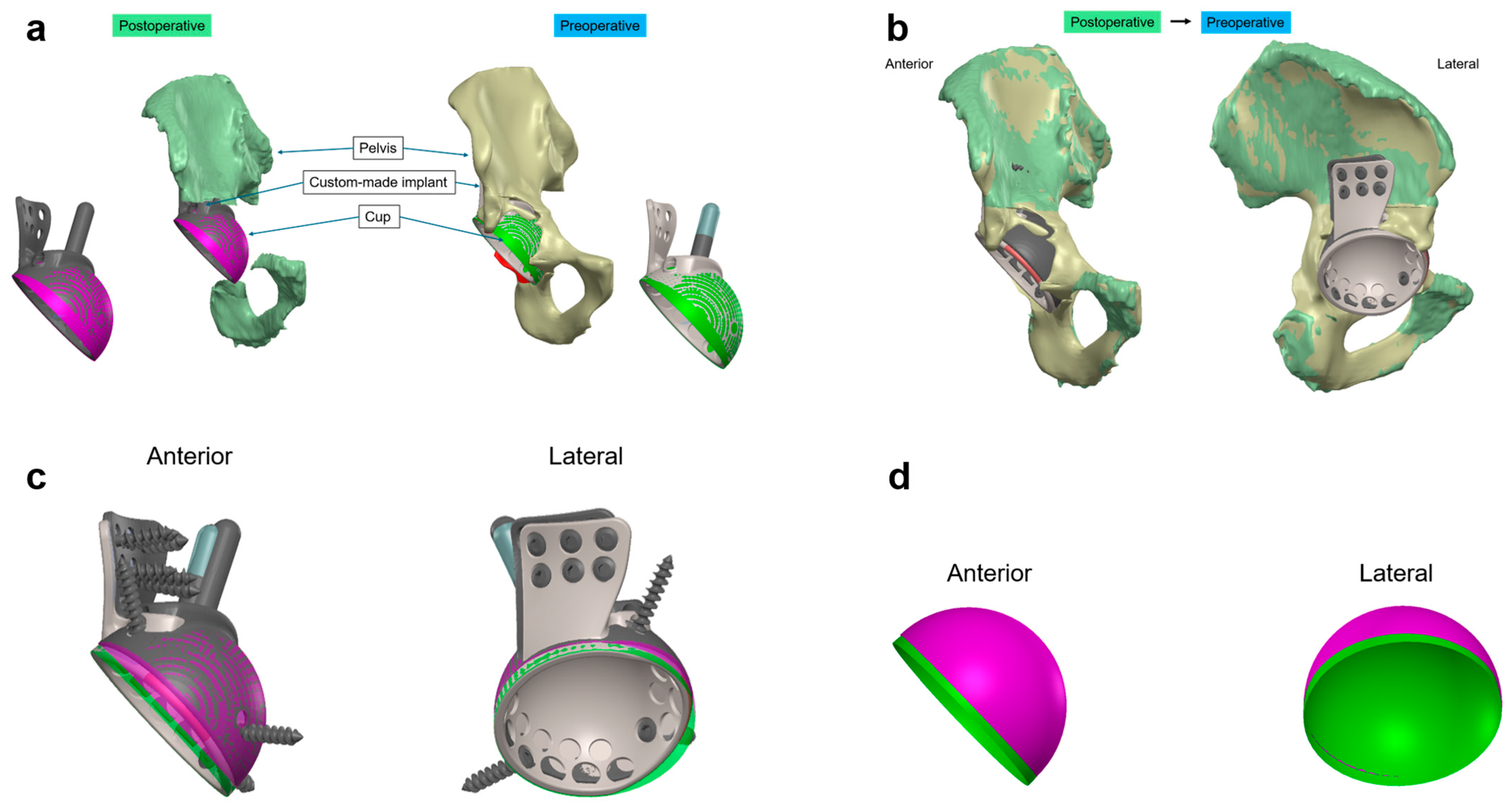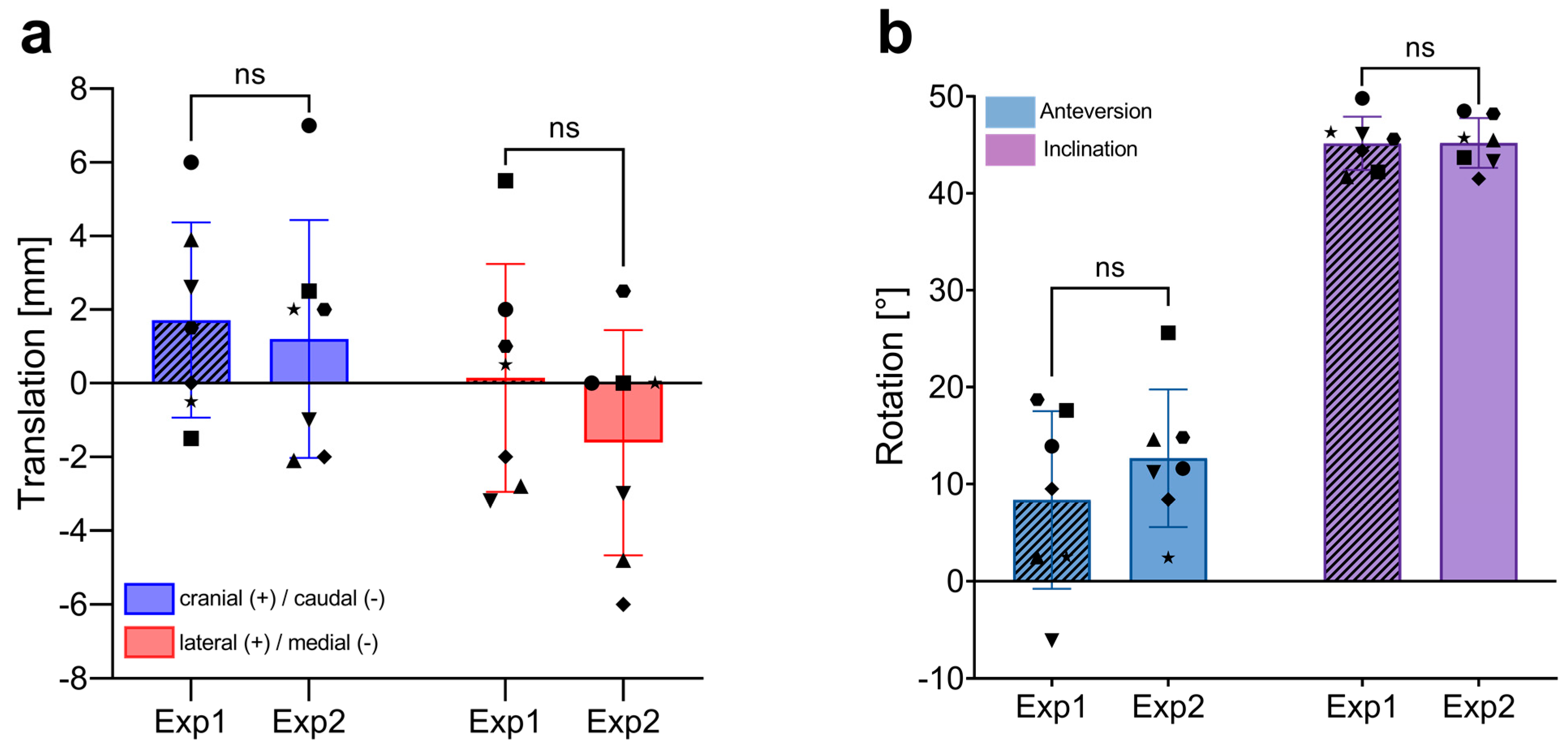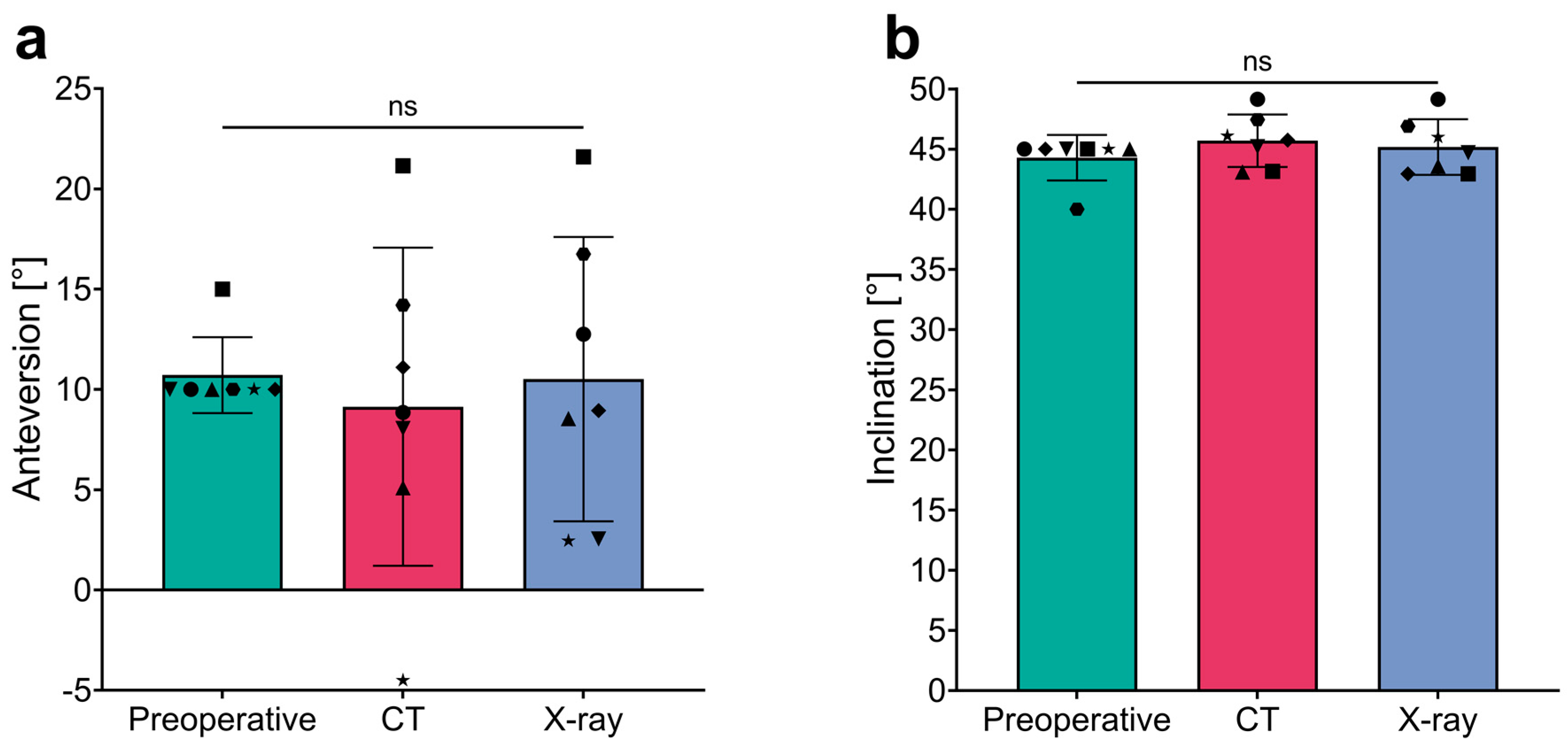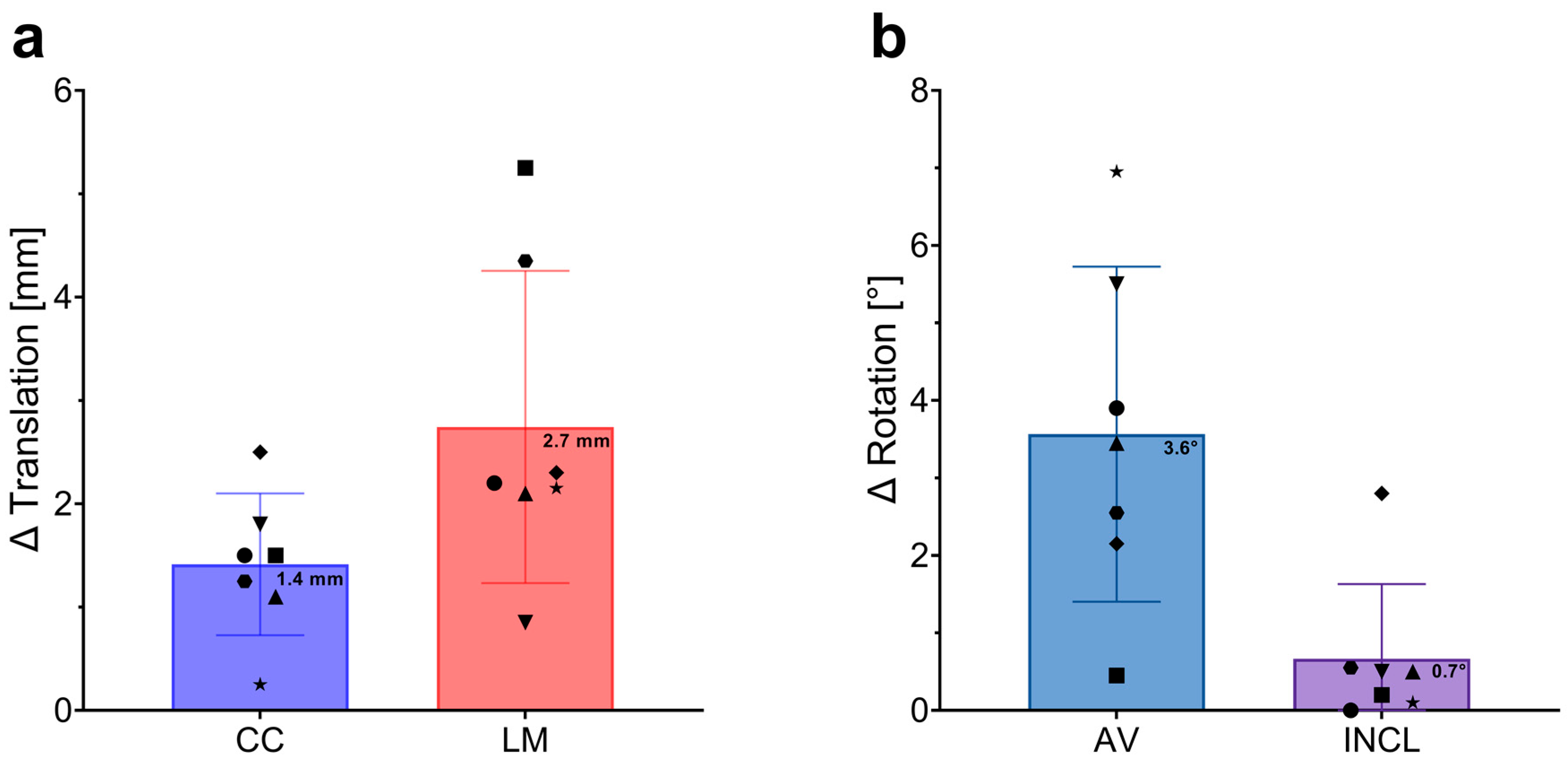Assessment Accuracy of 2D vs. 3D Imaging for Custom-Made Acetabular Implants in Revision Hip Arthroplasty
Abstract
1. Introduction
2. Materials and Methods
2.1. Study Design
2.2. Patients
2.3. Custom-Made Acetabular Implants: Planning and Manufacturing
2.4. Surgical Procedure
2.5. Quantitative Analysis of Implant Positioning Accuracy: 3D CT-Based Alignment
2.6. Quantitative Analysis of Implant Positioning Accuracy: 2D Radiograph-Based Alignment
2.7. Statistical Analyses
3. Results
3.1. Study Population
3.2. Interobserver Variability Using 3D CT-Based Alignment
3.3. Interobserver Variability Using 2D Radiograph-Based Alignment
3.4. Outcome of Implant Rotation in Relation to Lewinnek’s Safe Zone
3.5. Accuracy Comparison of Implant Position Assessment between 3D CT and 2D Plane Radiograph-Based Alignment
4. Discussion
5. Conclusions
Author Contributions
Funding
Institutional Review Board Statement
Informed Consent Statement
Data Availability Statement
Acknowledgments
Conflicts of Interest
References
- Learmonth, I.D.; Young, C.; Rorabeck, C. The operation of the century: Total hip replacement. Lancet 2007, 370, 1508–1519. [Google Scholar] [CrossRef] [PubMed]
- Shichman, I.; Roof, M.; Askew, N.; Nherera, L.; Rozell, J.C.; Seyler, T.M.; Schwarzkopf, R. Projections and Epidemiology of Primary Hip and Knee Arthroplasty in Medicare Patients to 2040–2060. JBJS Open Access 2023, 8, e22.00112. [Google Scholar] [CrossRef] [PubMed]
- Labek, G.; Thaler, M.; Janda, W.; Agreiter, M.; Stöckl, B. Revision rates after total joint replacement. J. Bone Jt. Surg. Br. Vol. 2011, 93-B, 293–297. [Google Scholar] [CrossRef]
- Rasmussen, M.B.; El-Galaly, A.; Daugberg, L.; Nielsen, P.T.; Jakobsen, T. Projection of primary and revision hip arthroplasty surgery in Denmark from 2020 to 2050. Acta Orthop. 2022, 93, 849–853. [Google Scholar] [CrossRef] [PubMed]
- Beswick, A.; Blom, A.W. Bone graft substitutes in hip revision surgery: A comprehensive overview. Injury 2011, 42, S40–S46. [Google Scholar] [CrossRef] [PubMed]
- Zhang, Y.; Gao, Z.; Zhang, B.; Du, Y.; Ma, H.; Tang, Y.; Liu, Y.; Zhou, Y. The application of custom-made 3D-printed titanium augments designed through surgical simulation for severe bone defects in complex revision total hip arthroplasty. J. Orthop. Traumatol. 2022, 23, 37. [Google Scholar] [CrossRef] [PubMed]
- Yeroushalmi, D.; Singh, V.; Maher, N.; Gabor, J.A.; Zuckerman, J.D.; Schwarzkopf, R. Excellent mid-term outcomes with a hemispheric titanium porous-coated acetabular component for total hip arthroplasty: 7–10 year follow-up. HIP Int. 2023, 33, 404–410. [Google Scholar] [CrossRef] [PubMed]
- Romagnoli, M.; Zaffagnini, M.; Carillo, E.; Raggi, F.; Casali, M.; Leardini, A.; Marcheggiani Muccioli, G.M.; Grassi, A.; Zaffagnini, S. Custom-made implants for massive acetabular bone loss: Accuracy with CT assessment. J. Orthop. Surg. Res. 2023, 18, 742. [Google Scholar] [CrossRef] [PubMed]
- Cadossi, M.; Garcia, F.L.; Sambri, A.; Andreoli, I.; Dallari, D.; Pignatti, G. A 2- to 7-Year Follow-Up of a Modular Iliac Screw Cup in Major Acetabular Defects: Clinical, Radiographic and Survivorship Analysis With Comparison to the Literature. J. Arthroplast. 2017, 32, 207–213. [Google Scholar] [CrossRef] [PubMed]
- Baauw, M.; van Hooff, M.L.; Spruit, M. Current Construct Options for Revision of Large Acetabular Defects: A Systematic Review. JBJS Rev. 2016, 4, e2. [Google Scholar] [CrossRef] [PubMed]
- Meding, J.B.; Meding, L.K. Custom Triflange Acetabular Implants: Average 10-Year Follow-Up. J. Arthroplast. 2023, 38, S201–S205. [Google Scholar] [CrossRef] [PubMed]
- Baauw, M.; Hellemondt, G.G.v.; Hooff, M.L.v.; Spruit, M. The accuracy of positioning of a custom-made implant within a large acetabular defect at revision arthroplasty of the hip. Bone Jt. J. 2015, 97-B, 780–785. [Google Scholar] [CrossRef] [PubMed]
- Durand-Hill, M.; Henckel, J.; Di Laura, A.; Hart, A.J. Can custom 3D printed implants successfully reconstruct massive acetabular defects? A 3D-CT assessment. J. Orthop. Res. 2020, 38, 2640–2648. [Google Scholar] [CrossRef] [PubMed]
- Qu, Z.; Yue, J.; Song, N.; Li, S. Innovations in 3D printed individualized bone prosthesis materials: Revolutionizing orthopedic surgery: A review. Int. J. Surg. 2024. [Google Scholar] [CrossRef] [PubMed]
- Anzillotti, G.; Guazzoni, E.; Conte, P.; Di Matteo, V.; Kon, E.; Grappiolo, G.; Loppini, M. Using Three-Dimensional Printing Technology to Solve Complex Primary Total Hip Arthroplasty Cases: Do We Really Need Custom-Made Guides and Templates? A Critical Systematic Review on the Available Evidence. J. Clin. Med. 2024, 13, 474. [Google Scholar] [CrossRef] [PubMed]
- Weber, M.; Witzmann, L.; Wieding, J.; Grifka, J.; Renkawitz, T.; Craiovan, B. Customized implants for acetabular Paprosky III defects may be positioned with high accuracy in revision hip arthroplasty. Int. Orthop. 2019, 43, 2235–2243. [Google Scholar] [CrossRef] [PubMed]
- Zampelis, V.; Flivik, G. Custom-made 3D-printed cup-cage implants for complex acetabular revisions: Evaluation of pre-planned versus achieved positioning and 1-year migration data in 10 patients. Acta Orthop. 2020, 92, 23–28. [Google Scholar] [CrossRef] [PubMed]
- Wessling, M.; Gebert, C.; Hakenes, T.; Dudda, M.; Hardes, J.; Frieler, S.; Jeys, L.M.; Hanusrichter, Y. Reconstruction of Paprosky III defects with custom-made implants: Do we get them in the correct position? Bone Jt. J. 2022, 104-B, 1110–1117. [Google Scholar] [CrossRef] [PubMed]
- Lewinnek, G.E.; Lewis, J.; Tarr, R.; Compere, C.; Zimmerman, J. Dislocations after total hip-replacement arthroplasties. JBJS 1978, 60, 217–220. [Google Scholar] [CrossRef]
- Isensee, F.; Jaeger, P.F.; Kohl, S.A.A.; Petersen, J.; Maier-Hein, K.H. nnU-Net: A self-configuring method for deep learning-based biomedical image segmentation. Nat Methods 2021, 18, 203–211. [Google Scholar] [CrossRef] [PubMed]
- Fedorov, A.; Beichel, R.; Kalpathy-Cramer, J.; Finet, J.; Fillion-Robin, J.C.; Pujol, S.; Bauer, C.; Jennings, D.; Fennessy, F.; Sonka, M.; et al. 3D Slicer as an image computing platform for the Quantitative Imaging Network. Magn. Reason. Imaging 2012, 30, 1323–1341. [Google Scholar] [CrossRef] [PubMed]
- Bayraktar, V.; Weber, M.; von Kunow, F.; Zeman, F.; Craiovan, B.; Renkawitz, T.; Grifka, J.; Woerner, M. Accuracy of measuring acetabular cup position after total hip arthroplasty: Comparison between a radiographic planning software and three-dimensional computed tomography. Int. Orthop. 2017, 41, 731–738. [Google Scholar] [CrossRef] [PubMed]
- Jiang, Z.; Han, X.; Zhao, C.; Wang, S.; Tang, X. Recent Advance in Biological Responsive Nanomaterials for Biosensing and Molecular Imaging Application. Int. J. Mol. Sci. 2022, 23, 1923. [Google Scholar] [CrossRef] [PubMed]
- Woerner, M.; Sendtner, E.; Springorum, R.; Craiovan, B.; Worlicek, M.; Renkawitz, T.; Grifka, J.; Weber, M. Visual intraoperative estimation of cup and stem position is not reliable in minimally invasive hip arthroplasty. Acta Orthop. 2016, 87, 225–230. [Google Scholar] [CrossRef] [PubMed]
- Barrack, R.L.; Krempec, J.A.; Clohisy, J.C.; McDonald, D.J.; Ricci, W.M.; Ruh, E.L.; Nunley, R.M. Accuracy of Acetabular Component Position in Hip Arthroplasty. JBJS 2013, 95, 1760–1768. [Google Scholar] [CrossRef] [PubMed]
- Choi, H.R.; Anderson, D.; Foster, S.; Beal, M.; Lee, J.A.; Barr, C.; Malchau, H.; McCarthy, J.; Kwon, Y.M. Acetabular cup positioning in revision total hip arthroplasty with Paprosky type III acetabular defects: Martell radiographic analysis. Int. Orthop. 2013, 37, 1905–1910. [Google Scholar] [CrossRef] [PubMed][Green Version]
- Abdel, M.P.; von Roth, P.; Jennings, M.T.; Hanssen, A.D.; Pagnano, M.W. What Safe Zone? The Vast Majority of Dislocated THAs Are Within the Lewinnek Safe Zone for Acetabular Component Position. Clin. Orthop. Relat. Res. 2016, 474, 386–391. [Google Scholar] [CrossRef] [PubMed]
- Fichtinger, G.; Troccaz, J.; Haidegger, T. Image-guided interventional robotics: Lost in translation? Proc. IEEE 2022, 110, 932–950. [Google Scholar] [CrossRef]
- Kim, K.; Kwon, S.; Kwon, J.; Hwang, J. A review of robotic-assisted total hip arthroplasty. Biomed. Eng. Lett. 2023, 13, 523–535. [Google Scholar] [CrossRef]
- Nawabi, D.H.; Conditt, M.A.; Ranawat, A.S.; Dunbar, N.J.; Jones, J.; Banks, S.; Padgett, D.E. Haptically guided robotic technology in total hip arthroplasty: A cadaveric investigation. Proc. Inst. Mech. Eng. Part H J. Eng. Med. 2013, 227, 302–309. [Google Scholar] [CrossRef] [PubMed]
- Elson, L.; Dounchis, J.; Illgen, R.; Marchand, R.C.; Padgett, D.E.; Bragdon, C.R.; Malchau, H. Precision of acetabular cup placement in robotic integrated total hip arthroplasty. Hip Int. 2015, 25, 531–536. [Google Scholar] [CrossRef] [PubMed]
- Domb, B.G.; El Bitar, Y.F.; Sadik, A.Y.; Stake, C.E.; Botser, I.B. Comparison of robotic-assisted and conventional acetabular cup placement in THA: A matched-pair controlled study. Clin. Orthop. Relat. Res. 2014, 472, 329–336. [Google Scholar] [CrossRef] [PubMed]
- Nakamura, N.; Sugano, N.; Nishii, T.; Miki, H.; Kakimoto, A.; Yamamura, M. Robot-assisted primary cementless total hip arthroplasty using surface registration techniques: A short-term clinical report. Int. J. Comput. Assist. Radiol. Surg. 2009, 4, 157–162. [Google Scholar] [CrossRef] [PubMed]
- Tarwala, R.; Dorr, L.D. Robotic assisted total hip arthroplasty using the MAKO platform. Curr. Rev. Musculoskelet. Med. 2011, 4, 151–156. [Google Scholar] [CrossRef] [PubMed]
- Xu, Y.; Zhang, F.; Zhai, W.; Cheng, S.; Li, J.; Wang, Y. Unraveling of Advances in 3D-Printed Polymer-Based Bone Scaffolds. Polymers 2022, 14, 566. [Google Scholar] [CrossRef] [PubMed]
- Dai, W.; Sun, M.; Leng, X.; Hu, X.; Ao, Y. Recent Progress in 3D Printing of Elastic and High-Strength Hydrogels for the Treatment of Osteochondral and Cartilage Diseases. Front. Bioeng. Biotechnol. 2020, 8, 604814. [Google Scholar] [CrossRef] [PubMed]
- Zhang, W.; Feng, C.; Yang, G.; Li, G.; Ding, X.; Wang, S.; Dou, Y.; Zhang, Z.; Chang, J.; Wu, C.; et al. 3D-printed scaffolds with synergistic effect of hollow-pipe structure and bioactive ions for vascularized bone regeneration. Biomaterials 2017, 135, 85–95. [Google Scholar] [CrossRef] [PubMed]
- He, Y.; Wang, W.; Tang, X.; Liu, X. Osteogenic induction of bone marrow mesenchymal cells on electrospun polycaprolactone/chitosan nanofibrous membrane. Dent. Mater. J. 2017, 36, 325–332. [Google Scholar] [CrossRef] [PubMed][Green Version]
- Hu, J.; Xu, T.; Shen, H.; Song, Y.; Yang, J.; Zhang, A.; Ding, H.; Xing, N.; Li, Z.; Qiu, L.; et al. Accuracy of Gallium-68 Pentixafor Positron Emission Tomography–Computed Tomography for Subtyping Diagnosis of Primary Aldosteronism. JAMA Netw. Open 2023, 6, e2255609. [Google Scholar] [CrossRef] [PubMed]






| Study Population | |
|---|---|
| Age, years ± SD (range) | 65.4 ± 8.0 (58–80) |
| Sex, n (%) | |
| Female | 5 (71.4) |
| Male | 2 (28.6) |
| BMI, kg/m2 ± SD (range) | 26.9 ± 6.8 (20.3–32.9) |
| Hip, n (%) | |
| Right | 3 (42.9) |
| Left | 4 (57.1) |
| Surgery, n (%) | |
| Revision | 7 (100) |
| One-stage | 4 (57.1) |
| Two-stage | 3 (42.9) |
| Cause, n (%) | |
| Septic loosening | 1 (14.3) |
| Aseptic loosening | 6 (85.7) |
| Time (CT—surgery), days ± SD (range) | 145 ± 85.3 (37–289) |
| Translation | ||||||||||
|---|---|---|---|---|---|---|---|---|---|---|
| 3D CT | 2D Radiographs | |||||||||
| Cranial (+)/Caudal (−) [mm] | Lateral (+)/Medial (−) [mm] | Ventral (+)/Dorsal (−) [mm] | Cranial (+)/Caudal (−) [mm] | Lateral (+)/Medial (−) [mm] | ||||||
| Patient No. | Mean | SD | Mean | SD | Mean | SD | Mean | SD | Mean | SD |
| 1 | 5 | 1 | −1.2 | 0.1 | −3 | 0.5 | 6.5 | 0.5 | 1 | 1 |
| 2 | 1 | 1 | −1.9 | 0 | −7.45 | 0.05 | 0.75 | 1.25 | 0.25 | 0.25 |
| 3 | 2 | 0 | −2.5 | 0.4 | 1.45 | 0.15 | 0.5 | 2 | 2.75 | 2.75 |
| 4 | 2 | 2 | −1.7 | 0.7 | 0 | 0.2 | 0.9 | 3 | −3.8 | 1 |
| 5 | 1.5 | 0.5 | −1.7 | 0.6 | −1.55 | 0.35 | −1 | 1 | −4 | 2 |
| 6 | 3 | 1 | −2.6 | 0.1 | 1 | 0.3 | 1.75 | 0.25 | 1.75 | 0.75 |
| 7 | −1 | 1 | −3.95 | 0.95 | 4.95 | 0.85 | 0.8 | 1.8 | −3.1 | 0.1 |
| Min. | −1.0 | 0.0 | −4.0 | 0.0 | −7.5 | 0.0 | −1.0 | 0.3 | −4.0 | 0.1 |
| Mean | 1.9 | 0.9 | −2.2 | 0.4 | −0.7 | 0.3 | 1.5 | 1.4 | −0.7 | 1.1 |
| Max. | 5.0 | 2.0 | −1.2 | 1.0 | 5.0 | 0.9 | 6.5 | 3.0 | 2.8 | 2.8 |
| Rotation | ||||||||||||||
|---|---|---|---|---|---|---|---|---|---|---|---|---|---|---|
| Preoperative Plan | 3D CT | 2D Radiographs | ||||||||||||
| Patient No. | AV Plan [°] | INCL Plan [°] | AV Final [°] | SD | ΔAV [°] | INCL Final [°] | SD | ΔINCL [°] | AV Final [°] | SD | ΔAV [°] | INCL Final [°] | SD | ΔINCL [°] |
| 1 | 10 | 45 | 8.85 | 0.65 | −1.15 | 49.15 | 0.15 | 4.15 | 12.75 | 1.15 | 2.75 | 49.15 | 0.65 | 4.15 |
| 2 | 10 | 45 | −4.5 | 5 | −14.5 | 46.1 | 0.1 | 1.1 | 2.45 | 0.05 | −7.55 | 46 | 0.3 | 1 |
| 3 | 15 | 45 | 21.15 | 0.05 | 6.15 | 43.15 | 0.05 | −1.85 | 21.6 | 4 | 6.6 | 42.95 | 0.75 | −2.05 |
| 4 | 10 | 45 | 5.1 | 2.5 | −4.9 | 43.1 | 1.5 | −1.9 | 8.55 | 6.05 | −1.45 | 43.6 | 1.9 | −1.4 |
| 5 | 10 | 45 | 11.1 | 0.3 | 1.1 | 45.75 | 0.05 | 0.75 | 8.95 | 0.55 | −1.05 | 42.95 | 1.45 | −2.05 |
| 6 | 10 | 40 | 14.2 | 0.9 | 4.2 | 47.45 | 0.05 | 7.45 | 16.75 | 1.95 | 6.75 | 46.9 | 1.3 | 6.9 |
| 7 | 10 | 45 | 8.05 | 0.05 | −1.95 | 45.2 | 0.2 | 0.2 | 2.55 | 8.65 | −7.45 | 44.7 | 1.4 | −0.3 |
| Min. | 10 | 40 | −4.5 | 0.0 | −14.5 | 43.1 | 0.0 | −1.9 | 2.5 | 0.1 | −7.6 | 43.0 | 0.3 | −2.1 |
| Mean | 10.7 | 44.3 | 9.1 | 1.4 | −1.6 | 45.7 | 0.3 | 1.4 | 10.5 | 3.2 | −0.2 | 45.2 | 1.1 | 0.9 |
| Max. | 15 | 45 | 21.2 | 5.0 | 6.2 | 49.2 | 1.5 | 7.5 | 21.6 | 8.7 | 6.8 | 49.2 | 1.9 | 6.9 |
Disclaimer/Publisher’s Note: The statements, opinions and data contained in all publications are solely those of the individual author(s) and contributor(s) and not of MDPI and/or the editor(s). MDPI and/or the editor(s) disclaim responsibility for any injury to people or property resulting from any ideas, methods, instructions or products referred to in the content. |
© 2024 by the authors. Licensee MDPI, Basel, Switzerland. This article is an open access article distributed under the terms and conditions of the Creative Commons Attribution (CC BY) license (https://creativecommons.org/licenses/by/4.0/).
Share and Cite
Nees, T.A.; Mueller, C.T.; Innmann, M.M.; Spranz, D.M.; Westhauser, F.; Renkawitz, T.; Reiner, T.; Walker, T. Assessment Accuracy of 2D vs. 3D Imaging for Custom-Made Acetabular Implants in Revision Hip Arthroplasty. J. Pers. Med. 2024, 14, 808. https://doi.org/10.3390/jpm14080808
Nees TA, Mueller CT, Innmann MM, Spranz DM, Westhauser F, Renkawitz T, Reiner T, Walker T. Assessment Accuracy of 2D vs. 3D Imaging for Custom-Made Acetabular Implants in Revision Hip Arthroplasty. Journal of Personalized Medicine. 2024; 14(8):808. https://doi.org/10.3390/jpm14080808
Chicago/Turabian StyleNees, Timo Albert, Christian Thomas Mueller, Moritz Maximilian Innmann, David Maximilian Spranz, Fabian Westhauser, Tobias Renkawitz, Tobias Reiner, and Tilman Walker. 2024. "Assessment Accuracy of 2D vs. 3D Imaging for Custom-Made Acetabular Implants in Revision Hip Arthroplasty" Journal of Personalized Medicine 14, no. 8: 808. https://doi.org/10.3390/jpm14080808
APA StyleNees, T. A., Mueller, C. T., Innmann, M. M., Spranz, D. M., Westhauser, F., Renkawitz, T., Reiner, T., & Walker, T. (2024). Assessment Accuracy of 2D vs. 3D Imaging for Custom-Made Acetabular Implants in Revision Hip Arthroplasty. Journal of Personalized Medicine, 14(8), 808. https://doi.org/10.3390/jpm14080808







